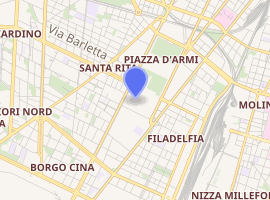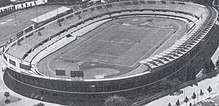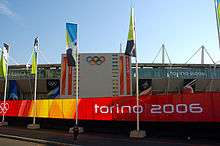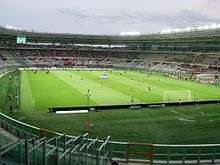Stadio Olimpico Grande Torino
The Stadio Olimpico Grande Torino[3] is a multi-purpose stadium located in Turin, Italy. It is the home ground of Serie A club Torino Football Club. The stadium is located in Piazzale Grande Torino, in the district of Santa Rita, in the south-central area of the city. The stadium is currently rated by UEFA as a Category 4 stadium, the highest ranking possible.
Stadio Municipale Benito Mussolini Stadio Comunale Vittorio Pozzo | |
 UEFA | |

| |
| Full name | Stadio Olimpico Grande Torino |
|---|---|
| Former names | Stadio Municipale Benito Mussolini Stadio Comunale Vittorio Pozzo |
| Location | Turin, Italy |
| Coordinates | 45°2′30.30″N 7°39′0.05″E |
| Owner | City of Turin |
| Capacity | 27,958[1][2] |
| Field size | 105 m x 68 m |
| Surface | Grass |
| Construction | |
| Built | September 1932 – May 1933 |
| Opened | 14 May 1933 |
| Renovated | 2006 |
| Tenants | |
| Torino (1958–1990, 2006–present) Juventus (1933–1990, 2006–2011) Italy national football team (selected matches) | |
Constructed in the 1930s, originally known as the Stadio Municipale and later the Stadio Comunale, it was the home of Juventus and Torino until 1990, when it was abandoned in favour of the Stadio delle Alpi. After a sixteen-year stint without Serie A football, the stadium was renovated and renamed the "Stadio Olimpico" on the occasion of the 2006 Winter Olympics. In a reversal of 1990, both Juventus and Torino moved back to the Olimpico, with Juventus using it until the end of the 2010–11 season, and Torino retaining it as their home stadium to the present day.
History
The original project: Stadio Municipale Benito Mussolini

Originally named after Benito Mussolini, the stadium was built to host the Games of the year Littoriali XI, held in 1933 and the World Student Games in the same year.
The Municipal Administration, to shorten the construction time, announced a contest, then divided the work among three companies: the stadium (stands, bleachers and local affairs) was entrusted to Company Saverio Parisi Rome (designed by the architect. Fagnoni and Eng. Bianchini and Ortensi), the athletic field, the Tower of Marathon and the ticket to 'Ing. Vannacci and Lucherini (project architect. Brenno Del Giudice, Professor. Colonnetti and the engineer. Vannacci), and the indoor pool to Company AN. Construction Companies Ing E. Faletti (project architect. Bonicelli and Ing. Villanova). L 'Ing. Guido De Bernardi undertook the preparation of fields and slopes.
Work began in September 1932. The stadium was inaugurated on 14 May 1933 by the Secretary of the Party, Achille Starace, at the beginning of Littoriali. The first match played in the new stadium was between Juventus and Hungary's Újpest FC (6–2), the return leg of the quarter-finals of the Central European Cup, on 29 June 1933.
Stadio Mussolini during the 1930s
The original design stage consisted of a vast ring ellipsoid, whose major perimeter was about 640 metres. The base consisted of a bench of white granite, on which rested the socket in red plaster. The same materials were formed at 45° planes, that mark three strips of glass for lighting indoors, crowned by a white railing. Over this, large windows overlooked, restricted by concrete pillars that supported the terminal swing, projecting more than three metres, with an inclination of 45 degrees.
The approaches were practised inside through openings 27, the main one of which led to the gallery, with cover from the weather. The parterre was partly covered by cantilevered terraces that adjective, and was slightly higher in the most distant from the field.
The playing field measures 70 x 105 metres, surrounded by an athletics track with six lanes, mass pits for the shot put and discus throw, the track for the long jump and the top corner. Initially, the curves of the athletics track were designed at three centres. After protests from the national executive Massimo Cartasegna (who had participated as an athlete in the 1908 Olympics), they were redesigned to a single centre. The end result, however, was that the track had an abnormal length of 446.38 metres.
The post-war municipal stadium
After the Stadium's inauguration, it hosted several matches of the 1934 FIFA World Cup, which was held in Italy. In the 1934–35 season, the Stadio Olimpico di Torino began to host matches for the League Cup. From the late fifties, it hosted the home games of both Turin teams in the Italian championship, until 1989–1990, when the stadium was abandoned for the Stadio delle Alpi, built for World Cup Italy 1990.
Between 1935 and 1986, Juventus were Italian champions 16 times, including five-in-a-row between 1931–1935, won 7 Italian Cups, several international titles, and one UEFA Cup (1976). For their part, between 1935 and 1976 Torino were 6 time Italian champions themselves (also with five in-a-row in the 1940s), and won 4 Italian Cups in the stadium.
From 1938 until the late 1950s, the stadium also housed the headquarters of the provisional Automobile Museum (opened in 1939).
In 1959 and 1970, it served as the main stadium of the Universiade and in 1980s the stadium was renamed "Vittorio Pozzo", in homage to the legendary coach who was twice World Champion with the Italy national football team in 1934 and 1938, who also coached Torino between 1912 and 1922.
After the construction of Stadio delle Alpi, the Communal Stadium was used less and less up to be intended only to accommodate the Juventus coach (until 2003) And, since 2004 those of Turin.[4][5]
The reconstruction for the 2006 Winter Olympics

Following the agreements with the City, which entrusted the Stadio delle Alpi to Juventus, it was assigned to Municipal Stadium Torino, for reconstruction and to be operational in time to host the opening and closing ceremonies of the Winter Olympics. However, due to the non-registration of the company grenade Championship (sanctioned definitively 9 August 2005), the City of Turin is the owner of the stadium and returned to complete the reconstructure.
The renovation project, consisting of two architects Verona Architect John Work Arteco and has maintained the existing structures, subject to the constraint of the Superintendency of Environmental and Architectural Heritage, and added new structures to withstand the vertical coverage of the entire plant, and a third ring of tiers, structurally continuous and cooperative coverage, with the corresponding part of the previous cover part 44 host closed boxes. Approximately one third of the lining of the roof is translucent plastic, so as to avoid as much as possible that the shadow cast by itself can damage the turf due to less sunlight. The total capacity is 27,168 seats, all covered and seated, lower than the original (originally the facility could accommodate 65,000 people standing) to meet modern safety standards.
For ceremonies, expansion was made to 35,000 seats by temporary structures, plus construction of massive construction scenes for technical preparation of the Olympic flame.
Many interior changes were made: the new main building on the ground floor of a commercial area of 1,163 square meters; in the north-west, also restored and relocated were the center of sports medicine, all services and offices. Outside was built a new Olympic Park and a new Olympic Sports Hall, designed by Arata Isozaki of Japan.
The renovation of the stadium cost 30 million euros. The new Olympic Stadium was officially presented 29 November 2005, in a ceremony attended by representatives of local, government, the International Olympic Committee and TOROC.
Return of football (2006-)

In 2006, the stadium returned to hosting football matches of the two city teams, Torino and Juventus. In 2011, Juventus moved to its new stadium called Juventus Stadium on the site of Stadio delle Alpi. At the end of the ground-share, Torino can decide to purchase the facility and could rename it "Stadium Grande Torino", said Mario Pescante on the occasion of the inauguration of the renovated stadium.
Despite having physically eliminated the athletics track (in its place is a carpet of synthetic grass), the distance between the stands and the pitch has not changed. This caused disappointment among fans, who would have preferred to have the stands closer to the field, as in England. However, during the restructuring a new parterre was built, bringing the crowd closer to the front rows. 80 seats are reserved for disabled spectators in wheelchairs, including 64 located in two tribunes raised in the parterre of the first ring of separate stations, 12 in the grandstand and 4 in the boxes.
The Olympic Stadium was the first stadium in Italy to fully comply with the dictates of the "Pisanu Law" on stadium security. More than 80 surveillance cameras allow the police to locate and identify perpetrators of violence. The glass enclosure that separates the field from the spectators area, is mobile. It is 2.2 metres (7 ft 3 in) high, but during games that do not raise risk of public policy may be lowered to 1.1 metres (3 ft 7 in). Furthermore, the use of technology was high: heating coils were placed below the field for use during cold temperatures and, in case of rain, an automatic system can cover the ground.
During its first two years of use, from 2006 to 2008, two separate security zones separated the opposing fans; the actual capacity was limited to 25,500 seats. During the summer of 2008 there were held extensive renovations, in view of the return of Juventus to the Champions League. 1,350 new seats were installed, in four rows behind the first row of the gallery, creating a new ring on the area where the old track. To promote visibility of spectators in these new rows, barriers have been lowered to 1.10 meters, compared to the previous 2.20 meters. Finally, 650 seats were recovered with the downsizing of guest areas. The capacity thus became approximately 27,500 seats.
During the summer of 2009, more work was performed. The parapet separation was lowered to 1.10 meters in all sectors and 444 new seats were added in the parterre, bringing the total stadium capacity to 27,994 seats. Moreover, in the summer of 2012, have been eliminated also the barriers that divided the Curva Maratona with Maratona Laterale (formerly the guest's sector in the home matches of Juventus in the same season moved to the new Juventus Stadium), allowing a further increase in capacity from 27,994 places in 2009, to 28,140 today.
In April 2016, the Olimpico was renamed the Stadio Olimpico Grande Torino in honour of the side from the 1940s.[2][6]
Stands
Curva Maratona (Curva Nord)
This section of the stadium is traditionally occupied by the nuclei of the most heated organised supporters of Torino during home games. This name has been attributed to the presence, since the time of the Municipal Stadium, in the area behind the curve itself, of a high tower, actually called "Marathon Tower", which opened near the entrance reserved for athletes participating in various kolous athletic contests.
Curva Primavera (Curva Sud)
Since reopening the facility after the Winter Olympics in 2006, the south bend was renamed the Curva Primavera in honour of the Torino youth teams. In Italian, this literally translates to "Spring Curve".
Distinti Est
The Distinguished East (the east area of the stadium when Torino plays) of the Olympic Stadium in Turin has been the meeting place of families within the facility. On the left side is a separate sector, reserved for fans of visiting teams.
Distinti Ovest
The Distinguished West was the most expensive stand of the Olympic Stadium. This second level is reserved exclusively for journalists, commentators and prominent figures.
Concerts
Formerly named Stadio Comunale
- Bob Marley & The Wailers – 28 June 1980
- Peter Tosh – 19 July 1980
- Iron Maiden – 2 September 1980
- Dire Straits – 1 July 1981
- Frank Zappa – 2 July 1982
- The Rolling Stones – 11–12 July 1982
- AC/DC – 7 September 1984
- David Bowie – 9 June 1987
- Madonna – 4 September 1987 (for 63,127 people)
- Sting – 3 May 1988
- Michael Jackson – 29 May 1988 (60 000 people)
- Bruce Springsteen & The E Street Band – 11 June 1988 65 000
- Pink Floyd – 6 July 1988
- Amnesty International's Human Rights Now! Benefit Concert – 8 September 1988 (The show was headlined by Bruce Springsteen and the E Street Band and also festuring, Sting, Peter Gabriel Tracy Chapman, Yossou N'Dour and Claudio Baglioni)
- Tina Turner – 5 May 1990
Stadio Olimpico
- Bruce Springsteen − 21 July 2009 (for 32,774)
- U2 – 6 August 2010, with Kasabian (for 42,441 people)
- Coldplay – Marina and the Diamonds – Rita Ora – 24 May 2012 (for 39,778 people)
- Muse – 28–29 June 2013 (for 65,228 people)
- One Direction – 6 July 2014 (for 38,430 people)
Other sports
On 9 November 2013, it hosted Italy’s end-of-year rugby union international against Australia who won 50 - 20.
References
- "Torino FC". Soccerway. Retrieved 22 October 2019.
- "Archived copy" (PDF). Archived from the original (PDF) on 1 September 2015. Retrieved 25 January 2016.CS1 maint: archived copy as title (link)
- "Stadio Olimpico Grande Torino" (in Italian). www.ticketone.it. Retrieved 22 October 2019.
- Pizzigallo, Claudio (21 April 2016). "SPECIALE STADI TORINO: I 5 impianti esistenti in cui hanno giocato Juve e Toro" (in Italian). Torino Today. Retrieved 22 October 2019.
- Pizzigallo, Claudio (21 April 2016). "Dall'Umberto I al "nuovo" Grande Torino, gli 11 stadi della storia calcistica torinese" (in Italian). Torino Today. Retrieved 22 October 2019.
- "Torino stadium renamed". Football Italia. 24 April 2016.
- 2006 Winter Olympics official report. Volume 3. pp. 103–4. (in English and Italian)
External links
| Wikimedia Commons has media related to Stadio Olimpico Grande Torino. |
- "Stadio Olimpico". comune.torino.it. Città di Torino.
- "Stadio Comunale Vittorio Pozzo già Mussolini e impianti sportivi". museotorino.it. Città di Torino.
- "Gli stadi della Juve". juventus.com. Juventus Football Club.
- "Lo stadio Olimpico". torinofc.it. Torino Football Club.
| Events and tenants | ||
|---|---|---|
| Preceded by Rice-Eccles Stadium Salt Lake City |
Winter Olympics Opening and Closing Ceremonies (Olympic Stadium) 2006 |
Succeeded by BC Place Vancouver |
| Preceded by Camp Nou Barcelona |
Inter-Cities Fairs Cup Final Venue 1965 |
Succeeded by Two legged Final |